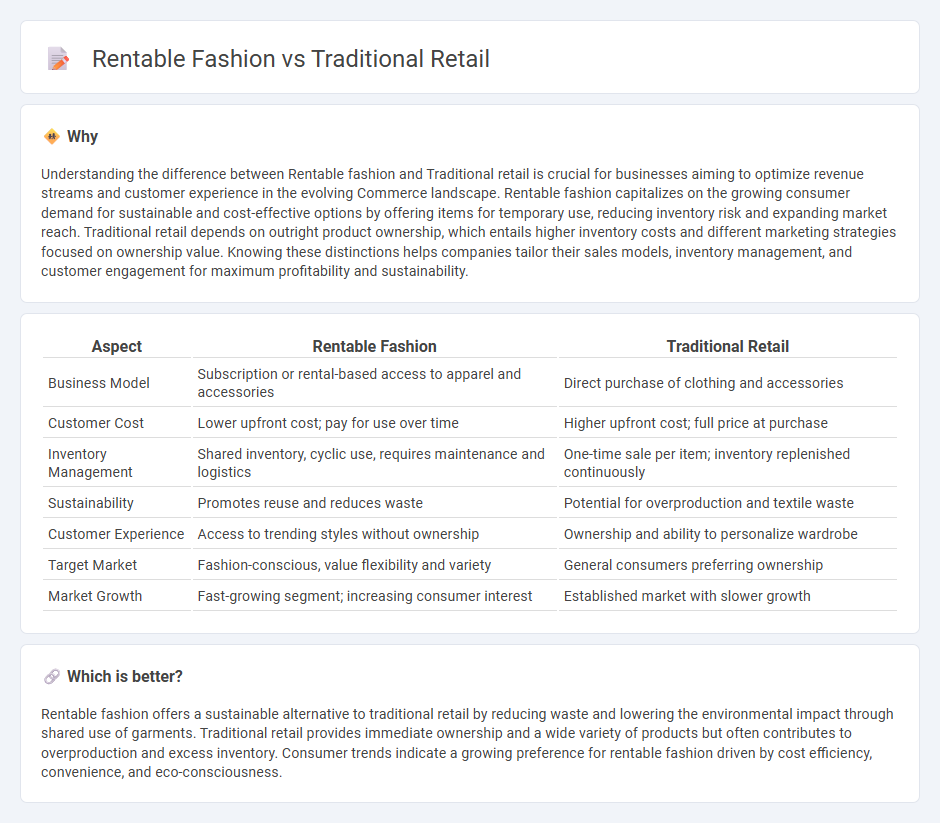
Rentable fashion revolutionizes commerce by offering consumers access to trendy apparel without permanent ownership, significantly reducing inventory costs and waste for retailers compared to traditional retail models. This innovative approach leverages subscription services and online platforms, enhancing convenience and sustainability while challenging the conventional buy-and-own retail paradigm. Explore the evolving dynamics between rentable fashion and traditional retail to understand their impact on the future of commerce.
Why it is important
Understanding the difference between Rentable fashion and Traditional retail is crucial for businesses aiming to optimize revenue streams and customer experience in the evolving Commerce landscape. Rentable fashion capitalizes on the growing consumer demand for sustainable and cost-effective options by offering items for temporary use, reducing inventory risk and expanding market reach. Traditional retail depends on outright product ownership, which entails higher inventory costs and different marketing strategies focused on ownership value. Knowing these distinctions helps companies tailor their sales models, inventory management, and customer engagement for maximum profitability and sustainability.
Comparison Table
| Aspect | Rentable Fashion | Traditional Retail |
|---|---|---|
| Business Model | Subscription or rental-based access to apparel and accessories | Direct purchase of clothing and accessories |
| Customer Cost | Lower upfront cost; pay for use over time | Higher upfront cost; full price at purchase |
| Inventory Management | Shared inventory, cyclic use, requires maintenance and logistics | One-time sale per item; inventory replenished continuously |
| Sustainability | Promotes reuse and reduces waste | Potential for overproduction and textile waste |
| Customer Experience | Access to trending styles without ownership | Ownership and ability to personalize wardrobe |
| Target Market | Fashion-conscious, value flexibility and variety | General consumers preferring ownership |
| Market Growth | Fast-growing segment; increasing consumer interest | Established market with slower growth |
Which is better?
Rentable fashion offers a sustainable alternative to traditional retail by reducing waste and lowering the environmental impact through shared use of garments. Traditional retail provides immediate ownership and a wide variety of products but often contributes to overproduction and excess inventory. Consumer trends indicate a growing preference for rentable fashion driven by cost efficiency, convenience, and eco-consciousness.
Connection
Rentable fashion enhances traditional retail by offering flexible wardrobe solutions that attract a broader customer base seeking sustainable and cost-effective apparel options. Traditional retailers integrate rentable fashion models to increase inventory turnover and reduce unsold stock, driving profitability. This synergy between rentable fashion and brick-and-mortar stores reshapes consumer shopping behavior and bolsters retail revenue streams.
Key Terms
Inventory management
Traditional retail relies heavily on forecasting and bulk purchasing to manage inventory, often risking overstock or stockouts due to demand variability. Rentable fashion platforms utilize real-time data and rotation cycles to optimize inventory turnover, reducing waste and improving customer satisfaction through a diversified offering. Explore how innovative inventory management strategies in rentable fashion are reshaping retail efficiency.
Revenue model
Traditional retail relies on upfront sales revenue generated by purchasing inventory, with profit margins influenced by wholesale costs and retail pricing strategies. Rentable fashion operates on a subscription or pay-per-use model, generating recurring revenue streams while reducing inventory holding costs and encouraging sustainable consumption. Explore the evolving revenue models reshaping the fashion industry's future.
Consumer ownership
Traditional retail relies on direct consumer ownership, where buyers purchase items outright and maintain long-term possession, fostering a sense of personal attachment and exclusivity. Rentable fashion shifts this model, offering temporary access to garments through subscription or rental services, reducing commitment and enabling frequent wardrobe changes without ownership burdens. Explore how consumer ownership influences identity and sustainability in evolving retail landscapes.
Source and External Links
Direct to Customer vs. Traditional Retail Business Model - The traditional retail business model involves selling products through a network of intermediaries such as wholesalers and retailers, with physical store presence, inventory management, and limited direct consumer interaction being key characteristics.
Retail vs. E-commerce: What's the Difference? - Traditional retail refers to selling goods from physical locations where customers can interact directly with staff, test products before buying, and avoid shipping costs.
The Fall of Traditional Retail Commerce - Traditional retail evolved from small shops to department stores, shopping malls, and big-box stores before the rise of ecommerce shifted consumer behavior away from brick-and-mortar stores.
 dowidth.com
dowidth.com